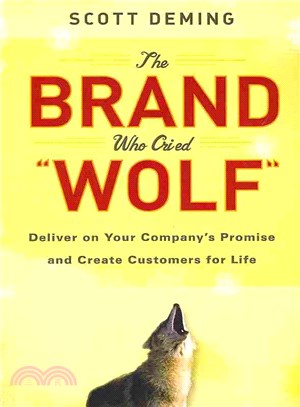The Brand Who Cried Wolf: Deliver On Your Company'S Promise And Create Customers For Life
商品資訊
ISBN13:9781118036761
出版社:John Wiley & Sons Inc
作者:Deming
出版日:2010/11/11
裝訂/頁數:平裝/224頁
商品簡介
"Powerful brands command. Read this insightful book and allow Scott to share how to make your brand stand out and deliver you buckets of money!"
—Mark Victor Hansen, bestselling author of the Chicken Soup for the Soul(r) series
"Deming's approach to branding is not about gimmicks. It's about relationships-the real formula for building and sustaining your brand and your business."
—Rieva Lesonsky, Editorial Director, Entrepreneur magazine
"It doesn't matter what you sell. We're all selling service. Deming's book shows businesses of all sizes how to create incredible brand power through innovative service levels. The Brand Who Cried Wolf will not end up on your book shelf; it will stay in your briefcase or on your desk as a daily reference guide. If you want to grow your business, get this book!"
—John Valletta, President, Super 8 Motels
"Deming's revelations on creating an emotionally engaging experience between you and your customer are without equal!"
—Joel Bauer, bestselling coauthor of How to Persuade People Who Don't Want to Be Persuaded
"The Brand Who Cried Wolf explains how every customer interaction, large or small, impacts your brand's image and reputation. This is an easy-to-read book— veryone in your organization needs to own."
—Patrick Sweeney, coauthor of the New York Times bestseller Succeed on Your Own Terms; cohost of the nationally syndicated radio show Winning in Business
"Deming delivers an essential message to businesses and delivers in a way you won't forget. You know the fairy tales, just adapt it to your unique brand: you!"
—Wayne Kandas, CFP and host of nationally syndicated Bloomberg Radio
"Stories sell, and that's what helps sell the ideas in this brilliant book. If you're in business-any business-you need this book. Get it now!"
—Robert G. Allen, bestselling coauthor of Cracking the Millionaire Code; CEO of The Enlightened Millionaire Institute
Chapter 8: Just Call Me Slick!
People Really Hate to be "Sold"
What We’ve Accomplished So Far
By now you know that branding is not exclusively about business identity in the form of a logo or advertising. You might recognize the Nike brand from its iconic swoosh logo. You might immediately think of McDonald’s when you think of fast food because McDonald’s commercials are ubiquitous, but by this point, you know that icons and awareness do not constitute a brand.
You also know that big businesses are not the only brands. Your business does not have to be the size of GM, Microsoft, AOL Time Warner or Wal-Mart. Your business could be run out of your home with you as the sole employee. You could conduct business from a small office with a single assistant, or in a store with several employees. The size, scope, and location of your business does not change the fact that it’s a brand, nor should any of these factors truly impact your brand if you’re focusing on one-on-one relationships.
Businesses are not the only brands, either. Every individual is a brand, as are organizations from non-profits to political parties to social clubs. For example, the Gates Foundation, the Red Cross, UNICEF, Make-A-Wish Foundation, Boy Scouts, Girl Scouts, Kiwanis Clubs, Rotary Clubs, Republican Party, and Democratic Party — all are brands. The concept of branding I’ve been articulating is personal, which means everyone needs to develop one.
Each category — from individuals to organizations to businesses large and small — brings with it its own brand development challenges. At the same time, however, these challenges are minimized when you understand your brand identity. Throughout this book, I have written about creating unique and memorable experiences for your customers. Chapter 2 defined a brand in terms of establishing relationships with your customers. Chapter 3 distinguished between types of experiences you can generate for your customers, and differentiated a brand experience from ones that are merely transactional or simply meet customer expectations. Chapter 4 highlighted the importance of changing your perspective to adopt your customer’s point of view, rather than emphasize your product or service. Chapter 5 analyzed the results of changing your perspective. Chapter 6 admonished you to avoid overstating your own worth. Finally, Chapter 7 focused on the ripple effects of your actions. Thus, most of the facets of branding I’ve been articulating since the beginning of this book have emphasized how you affect the customer’s perceptions. In other words, I’ve been talking about the customer’s connection to your brand. Now I’m going to talk about how you perceive your own brand, and about your connection to your own brand.
Creating An Authentic Brand Identity: Sincerity Can’t Be Faked!
First, you must take stock of your brand identity. In the Introduction to this book I stated that everyone is a brand. Everyone has a brand identity, but not everyone understands their own brand correctly, or even knows what it is. You cannot develop an authentic, sincere brand without this understanding. And you cannot create brand evangelists — people who trust you and praise your brand every chance they get — without an authentic, sincere brand. You earn someone’s trust through your actions, so you’d better know how to act!
Understanding your brand identity, and developing the trust that turns your customers into evangelists, involves knowing what your own beliefs and values are. The fact is, when you walk in your customer’s shoes, when you change your perspective to deliver the impossible, you’re reflecting a core element of your identity, your values, and your beliefs. When you are sincere about trying to understand your customers’ needs, desires, and what they’d truly love from you, a genuine connection is made that is the foundation of trust between you and your customers.
Compassion and sincerity can’t be faked. Branding is not a matter of putting on a persona that others will like. It’s not playing a role, putting on a mask, or pretending — all that is superficial, a veneer that covers up the “real” you. Moreover, a veneer can be quickly spotted. I don’t think there’s anyone that hasn’t had the experience of being “sold.” It’s uncomfortable precisely because it’s not authentic. The experience simply feels hollow. Think about the slick car salesman who’s “going to do what it takes to get you into this car!” Maybe he’s heavy on the ‘hale fellow well met,’ demeanor, or drenches you with flattery. When the time comes to make an offer on the car, he engages in an overly dramatic show of anxiety. “I’m gonna see my manager right now and see if I can talk him into this one. Between you and me, he’s having a bad day, but I’m really gonna work on him.” Eventually, the long, drawn out ceremonial dance ends with you signing the lease or sale papers, but you walk away knowing the whole experience could have been different, and you dread the prospect of going through it again.
Why do you dread it? What has soured you on going through the process again? In a word: insincerity. Insincerity is the wolf trotting around in sheep’s clothing pretending to be something he’s not. When you experience a wolf in sheep’s clothing, you’re soured on future interactions. It is this sort of insincerity that destroys a brand or prevents an authentic one from being established.
The car salesman example is cliché, just like the sales girl at the clothing store who tells you every single piece of clothing you try on looks so good! Though they’re cliché for a reason, we tend to forget just what that reason is. We instantly recognize the cliché, but not what made it true in the first place.
作者簡介
目次
What's Up with the Children's Stories?
Creating Beliefs That Shape Your Brand!
Acknowledgments.
Introduction.
"The Boy Who Cried 'Wolf'"
Chapter 1: You're Not a Marketing Animal? This Book's Still for You!
Branding versus Advertising and Marketing—Completely Different Animals.
The Story of the Eagle, the Crow, and the Shepherd.
You Build and Sustain the Brand!
Advertising as Awareness.
Marketing as a System of Uniting Businesses and Customers.
Branding Is a Process of Creating Authentically Unique, Emotional Experiences That Yield Evangelicals.
Widening the Scope of What Constitutes a Brand.
I'm a Brand,You're a Brand—We're All Brands!
Chapter 2: This Is Not Your Father’s Branding Formula.
Defining a Brand.
"The Tortoise and the Hare"
Successful Brands Defy Expectations.
Defying Expectations Means Overdelivering on Your Brand Promise.
Chapter 3: You Got What You Came For—I Did My Job . . . Didn’t I?
A Typical Service versus a Unique Experience.
"The Crow and the Pitcher"
Building a Brand Doesn't Happen Overnight (Don't Kill Your Golden Goose!)
Building a Brand: A Mere Transaction, a Typical Service, or a Unique Experience?
Transactional versus Unique Experiences.
Typical Service versus Unique Experience.
The Unique, Emotional, Memorable Experience.
Chapter 4: Forget About Me and My Stuff; Let's Talk About You!
Creating the Ultimate Customer Experience.
"The Lion and the Mouse"
Developing Relationships:The Heart and Soul of Branding.
Transcending the Typical: Michelene,Nayan, and Ray.
Branding: If You Build It,They Will Come—But You've Got to Sustain It!
Chapter 5: Can I Borrow Your Shoes?
Walking a Mile in Your Customers'—and Your Employees'—Shoes.
"The Frog Prince"
I Am My Customer.
Your Customers Are Not Clones! Avoid Thinking Exclusively in Terms of a Core Customer.
Be Your Customers and Employees:You Can Fit into Any Size Shoe!
Chapter 6: Get Over Yourself!
We're Not as Great as We Think We Are.
"The Fox and the Crow"
The Lake Wobegon Effect.
Yeah,You’re Good, But Not That Good!
Avoiding the Lake Wobegon Effect.
Chapter 7: You Talkin' to Me?
You Never Know Who You’re Dealing With!
"Puss-in-Boots"
Your Actions Generate Far-Reaching Ripples.
Some Words Are Actions.
Avoiding Negative Ripples.
Chapter 8: Just Call Me Slick!
People Really Hate to Be "Sold"
"The Wolf in Sheep's Clothing"
What We've Accomplished So Far.
Creating an Authentic Brand Identity: Sincerity Can't Be Faked!
Inauthentic Brand Identities.
Your Brand Identity Is Deeply Personal.
How Big Organizations Must Generate Personal Brands.
Chapter 9: Branding? LOL!
Branding for the Technology-Driven Business.
"The Three Little Pigs"
What Technology Does for Us.
The Downside of Mass Communication.
How to Use Technology to Extend Your Reach of Influence.
Chapter 10: Bringing It All Together.
Understanding the Roles and Fusion of Advertising and Branding to Create the Ultimate Branding Machine.
"The Circus Barker:An Original Deming Tail"
Your Brand Is Your Foundation.
Avoid Driving Customers to a Flawed Service!
Conclusion.
Bibliography.
Index.
主題書展
更多書展今日66折
您曾經瀏覽過的商品
購物須知
外文書商品之書封,為出版社提供之樣本。實際出貨商品,以出版社所提供之現有版本為主。部份書籍,因出版社供應狀況特殊,匯率將依實際狀況做調整。
無庫存之商品,在您完成訂單程序之後,將以空運的方式為你下單調貨。為了縮短等待的時間,建議您將外文書與其他商品分開下單,以獲得最快的取貨速度,平均調貨時間為1~2個月。
為了保護您的權益,「三民網路書店」提供會員七日商品鑑賞期(收到商品為起始日)。
若要辦理退貨,請在商品鑑賞期內寄回,且商品必須是全新狀態與完整包裝(商品、附件、發票、隨貨贈品等)否則恕不接受退貨。
























